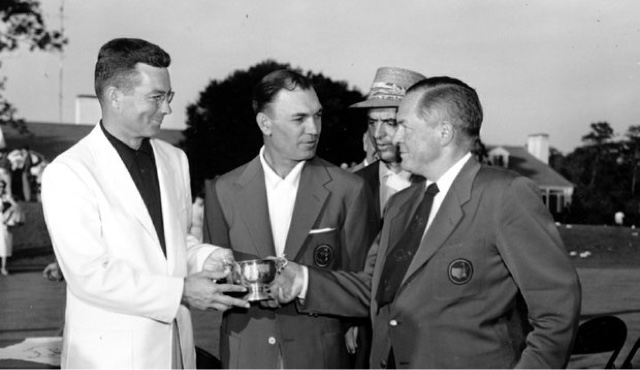Moe Norman was a golfing savant. While never formally diagnosed as such, I think most of those who knew him would agree that he was likely autistic. Unfortunately for Moe, and the rest of us, Moe's time on the PGA tour was shortlived as a result. His quirkiness led to him being essentially warned off the tour. The PGA tour just wasn't ready for the likes of Moe Norman.
Apparently, one of the final straws was when Moe actually putted between a fellow competitor's feet as he was picking his ball out of the hole. It was felt that Moe just wasn't taking the whole PGA tour pro thing seriously enough. It is kind of funny when you understand Moe. To him golf was simple. He summed the game up by saying you hit this dumb thing--the ball--with this dumb thing--the club--over there--the target. All the pre-shot routine stuff was lost on him. He just stepped up to the ball, looked at the target, and let it go. This is something that was then, and is probably even more so now, sadly missing with most other pros. The pace of play has become a nightmare.
Everyone who saw Moe hit balls knew they were observing pure genius. There have been others who struck the ball as well as Moe--Byron Nelson, Ben Hogan, Lee Trevino, and Sam Snead instantly come to mind. But only Moe seemed to be able to hit the ball dead straight, without a hint of a draw or fade. And Moe was able to do this with a set up and a swing unlike any other in professional golf.
Moe's swing, at a first glance, looked like a thirty-handicapper's. He stood with his feet stretched wide apart and had very little knee bend. He reached for the ball and held his extra-thick grips in the palms of his hands. His swing was short, with very little, if any, body rotation. He had a strong lateral shift on the downswing. It was definitely not the sort of swing likely to be admired or copied. But the strike was incredible. He hit it dead straight almost every time. And, after all, what's the shortest distance to the hole? You got it--a straight line.
Now, there have been, and still are, people teaching what is purported to be Moe's method. To listen to them, you would think his method was just as complicated as any other swing method being taught out there. They seem to have managed to take something that, for Moe at least, was very simple and make it very complicated. I think it is much better to listen to Moe's own words to understand what he was doing and why he was doing it.
The reason I am writing this is because my back problems have me presently unable to hit the ball much more than two hundred yards using a conventional swing. That Moe never experienced back trouble, and his swing was essentially a lateral move, with very little body rotation, makes me wonder whether it isn't time for me to try to use something resembling Moe's method again. I've used it before and played pretty well that way. And when I say "Moe's method," and not "Moe's swing," it is because Moe never suggested that anyone copy his swing, or his set up. He wanted people to understand the perfect strike and how to achieve it.
Moe developed a method that kept the clubface square to the target longer than anyone through the impact zone. He claimed his clubface remained square to the target twenty two inches after impact. Byron Nelson developed a method that kept his face square to the target for twelve inches after impact. Lee Trevino is another great ballstriker who kept his club moving down the target line a long time, for years favouring what he described as a push fade. As he got older, and experienced back problems, he has turned to a push draw. All three of these great ballstrikers, and more, believed that the longer the clubface remained square to the target, immediately before and after impact, the higher the probability that a good shot would result.
Just using common sense, the longer the clubface remains square to the target both before and after impact, the better the chance of a square strike almost regardless of ball position. A square strike, if the clubface is moving straight down the target line, means a straight shot. And a square strike increases the smash factor, which helps improve distance for those like me who are losing it in a big way.
For those of us with bad backs that are making the golf swing difficult, if not downright impossible, Moe's method might just be worth investigationg. Moe hit millions of golf balls. At the age of 63, Moe hit balls essentially non-stop for six hours in the production of a video for the PGA of America. He never experienced back trouble. Hitting a golf ball to Moe was as simple as hammering nails for a carpenter.
So, the question is, can I find a way to be able to hit balls like Moe with a buggered back? I think Moe provides the answer and I intend to try making some relatively simple changes to see if it can possibly work for me even half as well as it worked for Moe. And those changes do not require me to necessarily use an extra wide stance, or extend my arms to reach for the ball, or even alter my grip to be more like Moe. It requires me to figure out a way to strike the ball like Moe did. I will keep you posted on how it works out.













